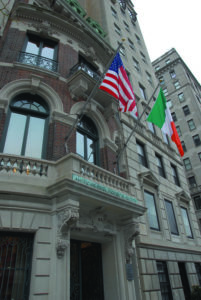Subpoenas Issued To American Irish Historical Society Board Members

New York’s Attorney General has subpoenaed key members of the American Irish Historical Society (AIHS) following the resignation of four board members.
The resignations came amidst plans to sell the society’s Fifth Avenue location and move upstate to the Cooperstown region, 200 miles from New York.
Two current board members and an employee will now be questioned under oath about management and other aspects of the society. While the AIHS has long been in the hands of the Cahill family, its current president-general is Irish President Michael D Higgins’ son, Michael Higgins Junior.
An investigation of the society has been underway since a petition, signed by over 40,000 people, asked for a complete review of the management of the institution which is home to invaluable manuscripts, books and historical artifacts.
Irishcentral has been reporting on the saga, including the million dollars of funding given to the society by the Irish government. The funding was approved on the understanding the government would be aware of all future development plans. However, they were not advised of the plan to move the AIHS upstate.
While Irish Foreign Minister Simon Coveney has called for AIHS to keep its Fifth Avenue location, the society is reported to have reduced the asking price of the building from $52 million to $44 million.
New Home For The Hunger Museum
The Gaelic American Club (GAC) in Fairfield, Connecticut, has been named as the new home of Ireland’s Great Hunger Museum. The announcement, on March 1, was made by Quinnipiac University, which has housed the artifacts since 2012.
Turlough McConnell, spokesperson for the committee to Save Ireland’s Great Hunger Museum, had been hoping to keep the museum in its current home in Hamden, just off the Quinnipiac campus. He issued a statement on behalf of the group in response to the announcement.
“We are shocked that Quinnipiac would make a rash decision to turn such a valuable collection over to a social club, moreover, one that does not have appropriate charitable status. Even more surprising is that it would do so while the Attorney General’s investigation [into the museum’s closure] is still ongoing.”
The group said it would await further explanation from the Attorney General’s office.
Quinnipiac’s statement outlined the University’s wishes to “preserve the collection, to have it displayed intact, and for it to remain in Connecticut in a more central location accessible to a broader public.”

The museum, spear-headed by former university President John L. Lahey, displays the largest collection of famine artifacts. In 2019, Quinnipiac announced the museum had until June 2020 to prove it could become self-sufficient or face permanent closure.
McConnell said the museum “was never intended as a money-making enterprise but as an educational enterprise.”
He said the group’s “concern always has been, and always will be, the story of Ireland’s Great Hunger as told through art and artifacts by leading artists, for which the university has shown a callous disregard.”
Among the items on display is a sculpture, “Famine Mother and Children,” by John Behan, who has commissioned famous famine memorials throughout Ireland. Also included in the collection is a stained-glass window inscribed with “An Gorta Mór” which translates to “The Great Hunger.”
As the potato blight ravaged the crop across Ireland – one million people died and up to two million emigrated – Britain further compounded the suffering of the Irish nation.
In 1997, the office of Prime Minister Tony Blair released a statement condemning the English government’s actions during the tragedy. It was around this time that John Lahey, who had been president of Quinnipiac since 1987, began to consider using the famine-related art collection he had acquired on behalf of the university to educate the American public on the atrocity.
Lahey, who retired in 2018, disagreed with current President Judy Olian’s administration’s decision to close the museum in 2020.
“I am perplexed why anyone in this day and time would even consider closing a museum dedicated to educating people about the evils of discrimination and bigotry.”
Olian spoke to CT Insider about the decision to no longer host the artifacts at Quinnipiac. “We need that space for other academic purposes, we have plans for that space and they really did not have a sustainable model.” She further claimed, that the museum, which averaged 20 visitors per day pre-pandemic, “was not as integrated in campus studies or lives as you would hope.”
CT Insider reported that no money is expected to change hands in the move, and that the GAC has agreed to raise the money, hire staff, prepare the space and maintain the museum permanently.
While it is currently not known why the GAC was chosen as the organization to take charge of the artifacts, it is a vibrant club with 6,000 members. The GAC is managed by Thomas O’Flaherty.♦


Leave a Reply